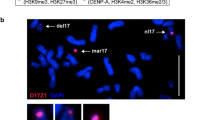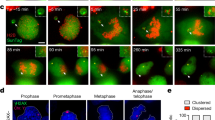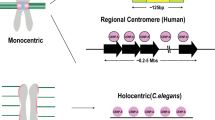Abstract
Neocentromeres are rare human chromosomal aberrations where a new centromere has formed in a previously non-centromeric location. The emergence of new centromeres on a chromosome that already contains an endogenous centromere would be a highly deleterious event which would lead to dicentricity and mitotic instability. Nonetheless, neocentromere formation appears to provide a mechanism for the acquisition of a new centromere. Neocentromeres are most often observed on chromosomal arm fragments that have separated from an endogenous centromere, and therefore actually lead to mitotic stability of what would have been an acentric fragment. Neocentromeres have recently also been observed on apparently unrearranged chromosomes where the endogenous centromere has been inactivated. Furthermore, the process of centromere repositioning during primate chromosomal evolution may depend on the acquisition and subsequent fixation of neocentromeres. This remarkable plasticity in the position of centromeres has important implications for human cytogenetics and chromosome evolution, and provides an opportunity to further our understanding of the process of centromere formation and structure.
Similar content being viewed by others
References
Aagaard L, Schmid M, Warburton PE, Jenuwein T (2000) Mitotic chromatin association of SUV39H, a novel component of active centromeres, correlates with cell cycle dependent phosphorylation. J Cell Sci 113: 817–829.
Alonso A, Mahmood R, Li S et al. (2003) Genomic microarray analysis reveals distinct locations for the CENP-A binding domains in three human chromosome 13q32 neocentromeres. Hum Mol Genet 12: 2711–2721.
Amor DJ, Choo KH (2002). Neocentromeres: role in human disease, evolution, and centromere study. Am J Hum Genet 71: 695–714.
Amor D, Bentley K, Ryan J et al. (2004) Human centromere repositioning ''in progress''. Proc Natl Acad Sci USA 101: 6542–6547.
Ando S, Yang H, Nozaki N, Okazaki T, Yoda K (2002) CENP-A,-B, and-C chromatin complex that contains the I-type alpha-satellite array constitutes the prekinetochore in HeLa cells. Mol Cell Biol 22: 2229–2241.
Barbi G, Spaich C, Adolph S, Kehrer-Sawatzki H (2003) Analphoid de novo marker chromosome inv dup(3) (q28qter) with neocentromere in a dysmorphic and developmentally retarded girl. J Med Genet 40: e27.
Barwell J, Mazzaschi R, Bint S, Ogilvie C, Elmsie F (2004) A new neocentromere locus on chromosome 13 resulting in mosaic tetrasomy for distal 13q and an asymmetric phenotype. Am J Med Genet (in press).
Bernard P, Allshire R (2002) Centromeres become unstuck without heterochromatin. Trends Cell Biol 12: 419.
Bernard P, Maure JF, Partridge JF et al. (2001) Requirement of heterochromatin for cohesion at centromeres. Science 294: 2539–2542.
Blower MD, Sullivan BA, Karpen GH (2002) Conserved organization of centromeric chromatin in flies and humans. Dev Cell 2: 319–330.
Choo KH (2001) Domain organization at the centromere and neocentromere. Dev Cell 1: 165–177.
Craig JM, Earle E, Canham P et al. (2003a) Analysis of mammalian proteins involved in chromatin modification reveals new metaphase centromeric proteins and distinct chromosomal distribution patterns. Hum Mol Genet 12: 3109–3121.
Craig JM, Wong LH, Lo AW, Earle E, Choo KH (2003b) Centromeric chromatin pliability and memory at a human neocentromere. EMBO J 22: 2495–2504.
Giglio S, Broman KW, Matsumoto N et al. (2001) Olfactory receptor-gene clusters, genomic-inversion polymorphisms, and common chromosome rearrangements. Am J Hum Genet 68: 874–883.
Goshima G, Kiyomitsu T, Yoda K, Yanagida M (2003) Human centromere chromatin protein hMis12, essential for equal segregation, is independent of CENP-A loading pathway. J Cell Biol 160: 25–39.
Grimbacher B, Dutra AS, Holland SM et al. (1999) Analphoid marker chromosome in a patient with hyper-IgE syndrome, autism, and mild metal retardation. Genet Med 1: 214–219.
Knegt AC, Li S, Engelen JJM, Bijlsma EK, Warburton PE (2002) Prenatal diagnosis of a karyotypically normal pregnancy in a mother with a supernumerary neocentric 13q21->13q22 chromosome and balancing reciprocal deletion. Prenat Diagn 23: 215–220.
Levy B, Papenhausen PR, Tepperberg JH et al. (2000) Prenatal molecular cytogenetic diagnosis of partial tetrasomy 10p due to neocentromereformationinaninversionduplicationanalphoid marker chromosome. Cyto Cell Genet 91: 165–170.
Li S, Malafiej P, Levy B et al. (2002) Chromosome 13q neocentromeres: Molecular cytogenetic characterization of three addtional cases and clinical spectrum. Am J Med Genet 110: 258–267.
Lo AW, Craig JM, Saffery R et al. (2001a) A 330 kb CENP-A binding domain and altered replication timing at a human neocentromere. EMBO J 20: 2087–2096.
Lo AW, Magliano DJ, Sibson MC et al. (2001b) A novel chromatin immunoprecipitation and array (CIA) analysis identifies a 460-kb CENP-A-binding neocentromere DNA. Genome Res 11: 448–457.
Montefalcone G, Tempesta S, Rocchi M, Archidiacono N (1999) Centromere repositioning. Genome Res 9: 1184–1188.
Nagaki K, Talbert PB, Zhong CX et al. (2003) Chromatin immunoprecipitation reveals that the 180-bp satellite repeat is the key functional DNA element of Arabidopsis thaliana centromeres. Genetics 163: 1221–1225.
Ohashi H, Wakui K, Ogawa K et al. (1994) A stable acentric marker chromosome: Possible existence of an intercalary ancient centromere at distal 8p. Am J Hum Genet 55: 1202–1208.
Papenhausen P, Gadi I, Tepperberg J et al. (2003) Trisomy 3q secondary to a terminal deletion/generation of a mirrorimage analphoid marker in a neonate. Am J Hum Genet 73: Suppl. A841.
Saffery R, Irvine DV, Griffiths B et al. (2000) Human centromeres and neocentromeres show identical distribution patterns of >20 functionally important kinetochoreassociated proteins. Hum Mol Genet 9: 175–185.
Saffery R, Sumer H, Hassan S et al. (2003) Transcription within a functional human centromere. Mol Cell 12: 509–516.
Satinover DL, Vance GH, VanDyke DL, Schwartz S (2001) Cytogenetic analysis and construction of a BAC contig across a common neocentromeric region from 9p. Chromosoma 110: 275–283.
Shen MH, Ross A, Yang J, de las Heras JI, Cooke H (2001) Neo-centromere formation on a 2.6Mb mini-chromosome in DT40 cells. Chromosoma 110: 421–429.
Stankiewicz P, Lupski JR (2002) Genome architecture, rearrangements and genomic disorders. Trends Genet 18: 74–82.
Sugawara H, Harada N, Ida T et al. (2003) Complex low-copy repeats associated with a common polymorphic inversion at human chromosome 8p23. Genomics 82: 238–244.
Sullivan BA, Blower MD, Karpen GH (2001) Determining centromere identity: cyclical stories and forking paths. Nat Rev Genet 2: 584–596.
Tyler-Smith C, Gimelli G, Giglio G et al. (1999) Transmission of a fully functional human neocentromere through three generations. Am J Hum Genet 64: 1440–1444.
Ventura M, Archidiacono N, Rocchi M (2001) Centromere emergence in evolution. Genome Res 11: 595–599.
Ventura M, Mudge JM, Palumbo V et al. (2003) Neocentromeres in 15q24-26 map to duplicons which flank an ancestral centromere in 15q25. Genome Res 13: 2059–2068.
Ventura A, Weigl S, Carbone L et al. (2004). Recurrent sites for new centromere seeding. Genome Res (in press).
Voullaire L, Saffery R, Earle E et al. (2001) Mosaic inv dup(8p) marker chromosome with stable neocentromere suggests neocentromerization is a post zygotic event. Am J Med Genet 102: 86–94.
Wandall A, Tranebjaerg L, Tommerup N (1998) A neocentromere on human chromosome 3 without detectable alpha satellite DNA forms morphologically normal kinetochores. Chromosoma 107: 359–365.
Warburton D (1991) De novo balanced chromosome rearrangements and extra marker chromosomes identified at prenatal diagnosis: clinical significance and distribution of breakpoints. Am J Hum Genet 49: 995–1013.
Warburton PE (2001) Epigenetic analysis of kinetochore assembly at human variant centromeres. Trends Genet 17: 243–247.
Warburton PE, Dolled M, Mahmood R et al. (2000) Molecular cytogenetic analysis of eight inversion duplications of human chromosome 13q that each contain a Am J Hum Genet 66: 1794–1806.
Warburton P, Barwell J, Splitt M et al. (2004) Class II neocentromeres: a putative common neocentromere site in band 4q12.2. Am J Med Genet 11: 749–753.
Williams BC, Murphy TD, Goldberg ML, Karpen GH (1998) Neocentromere activity of structurally acentric mini-chromosomes in Drosophila. Nature Genet 18: 30–37.
Author information
Authors and Affiliations
Rights and permissions
About this article
Cite this article
Warburton, P.E. Chromosomal dynamics of human neocentromere formation. Chromosome Res 12, 617–626 (2004). https://doi.org/10.1023/B:CHRO.0000036585.44138.4b
Issue Date:
DOI: https://doi.org/10.1023/B:CHRO.0000036585.44138.4b




